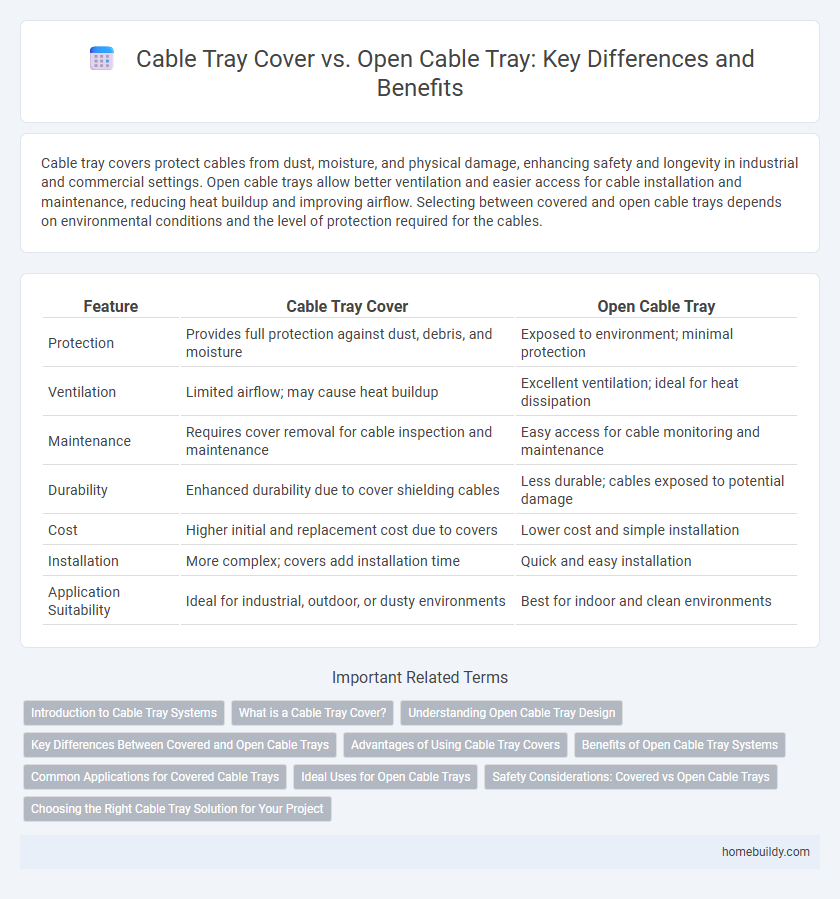Cable tray covers protect cables from dust, moisture, and physical damage, enhancing safety and longevity in industrial and commercial settings. Open cable trays allow better ventilation and easier access for cable installation and maintenance, reducing heat buildup and improving airflow. Selecting between covered and open cable trays depends on environmental conditions and the level of protection required for the cables.
Table of Comparison
| Feature | Cable Tray Cover | Open Cable Tray |
|---|---|---|
| Protection | Provides full protection against dust, debris, and moisture | Exposed to environment; minimal protection |
| Ventilation | Limited airflow; may cause heat buildup | Excellent ventilation; ideal for heat dissipation |
| Maintenance | Requires cover removal for cable inspection and maintenance | Easy access for cable monitoring and maintenance |
| Durability | Enhanced durability due to cover shielding cables | Less durable; cables exposed to potential damage |
| Cost | Higher initial and replacement cost due to covers | Lower cost and simple installation |
| Installation | More complex; covers add installation time | Quick and easy installation |
| Application Suitability | Ideal for industrial, outdoor, or dusty environments | Best for indoor and clean environments |
Introduction to Cable Tray Systems
Cable tray covers provide enhanced protection against dust, moisture, and mechanical damage, making them ideal for environments requiring added safety and cleanliness. Open cable trays allow for easier cable installation, visual inspection, and improved heat dissipation but are more susceptible to environmental contaminants. Selecting between cover and open cable trays depends on the specific requirements of cable protection, accessibility, and maintenance needs in the cable management system.
What is a Cable Tray Cover?
A cable tray cover is a protective barrier designed to shield cables within an open cable tray from environmental factors such as dust, moisture, and physical damage, enhancing safety and cable longevity. It helps maintain organized cable management by preventing debris accumulation and reduces the risk of electrical hazards by protecting exposed wiring. Compared to open cable trays, covered trays provide better protection in harsh industrial settings or outdoor installations where cables require additional safeguarding.
Understanding Open Cable Tray Design
Open cable tray design offers superior ventilation and easy access for cable maintenance compared to cable tray covers, reducing heat buildup and facilitating quick inspections. Its exposed structure allows cables to breathe, minimizing the risk of overheating in data centers or industrial installations. While cable tray covers provide mechanical protection, open cable trays are ideal for environments where flexibility and airflow are prioritized.
Key Differences Between Covered and Open Cable Trays
Cable tray covers provide enhanced protection against dust, moisture, and physical damage, making them ideal for outdoor or industrial environments where cable safety and longevity are critical. Open cable trays offer superior ventilation and easier access for maintenance or cable additions, preferred in indoor settings where cooling and quick inspections are essential. The choice depends on environmental exposure, cable type sensitivity, and maintenance priorities, with covered trays prioritizing protection and open trays prioritizing accessibility.
Advantages of Using Cable Tray Covers
Cable tray covers protect cables from dust, moisture, and mechanical damage, extending the lifespan of electrical wiring systems. They enhance safety by preventing accidental contact with live cables and reducing fire hazards caused by debris accumulation. Installing cable tray covers also improves cable management, maintaining an organized and clean appearance in industrial and commercial environments.
Benefits of Open Cable Tray Systems
Open cable tray systems provide superior ventilation, reducing heat buildup and enhancing the lifespan of electrical cables. They offer easier access for maintenance, inspection, and cable modifications without the need to remove covers. Cost efficiency is improved due to lower material and installation expenses compared to covered trays.
Common Applications for Covered Cable Trays
Covered cable trays are commonly used in environments requiring protection from dust, moisture, and physical damage, such as industrial plants, commercial buildings, and hazardous locations. They provide enhanced safety and durability by shielding cables from external contaminants and mechanical impact, making them ideal for outdoor installations and areas with stringent electrical codes. Open cable trays, by contrast, are typically employed in dry, clean indoor spaces where easy access and ventilation for cables is a priority.
Ideal Uses for Open Cable Trays
Open cable trays are ideal for environments requiring frequent cable access, such as data centers and industrial facilities where quick inspection, maintenance, or upgrades are necessary. Their design allows for superior ventilation, preventing overheating of cables in high-power or high-density installations. Open trays are also preferred in spaces with complex cable routing due to ease of cable addition or re-routing without dismantling covers.
Safety Considerations: Covered vs Open Cable Trays
Covered cable trays provide enhanced protection against dust, moisture, and physical damage, significantly reducing the risk of electrical hazards and ensuring compliance with safety standards. Open cable trays allow better ventilation and heat dissipation but expose cables to environmental contaminants and accidental impacts, which may increase maintenance needs and safety risks. Selecting between covered and open cable trays depends on the specific installation environment, exposure levels, and regulatory safety requirements.
Choosing the Right Cable Tray Solution for Your Project
Choosing the right cable tray solution depends on project requirements such as environmental protection, load capacity, and accessibility. Cable tray covers provide enhanced protection against dust, moisture, and physical damage, making them ideal for outdoor or industrial settings. Open cable trays offer easier cable access and ventilation, suitable for indoor environments where maintenance and cooling are priorities.
Cable tray cover vs Open cable tray Infographic

 homebuildy.com
homebuildy.com